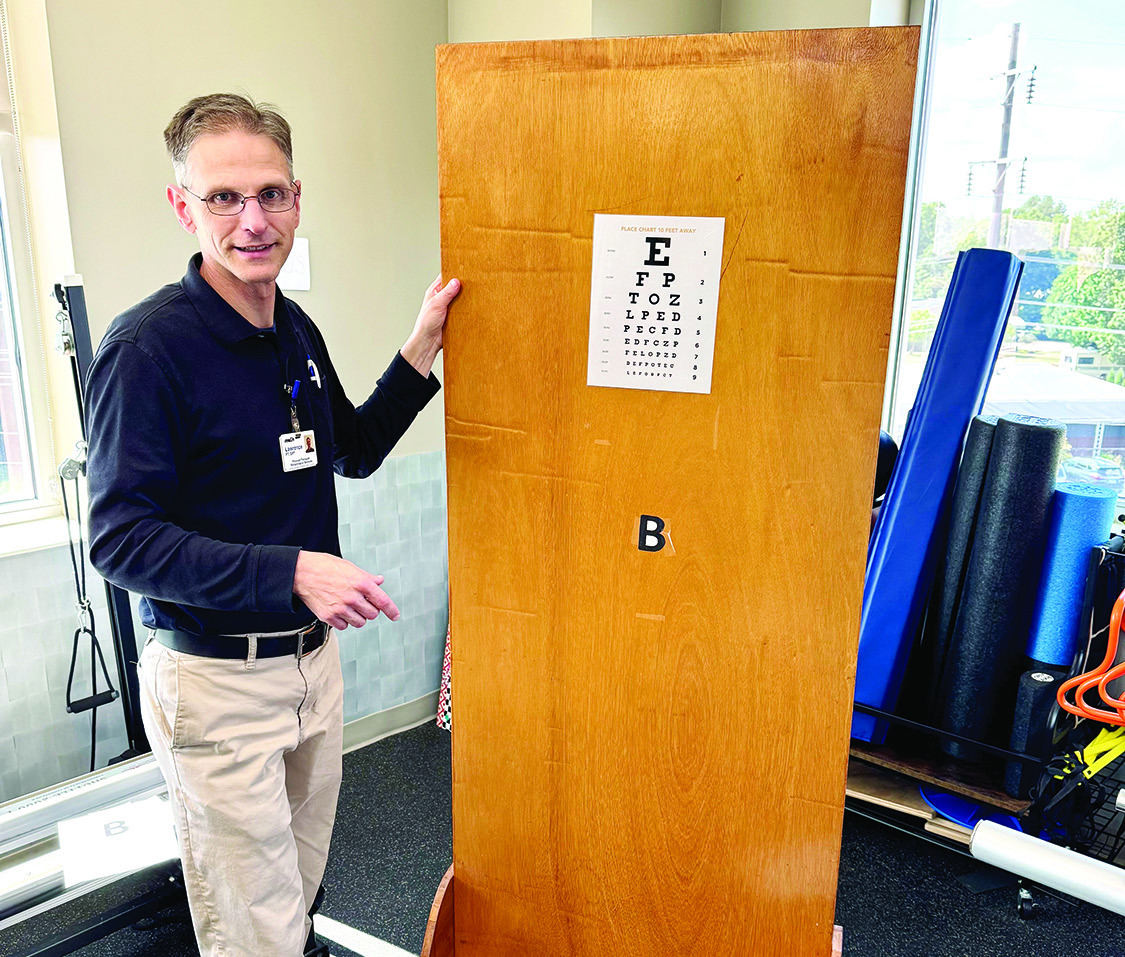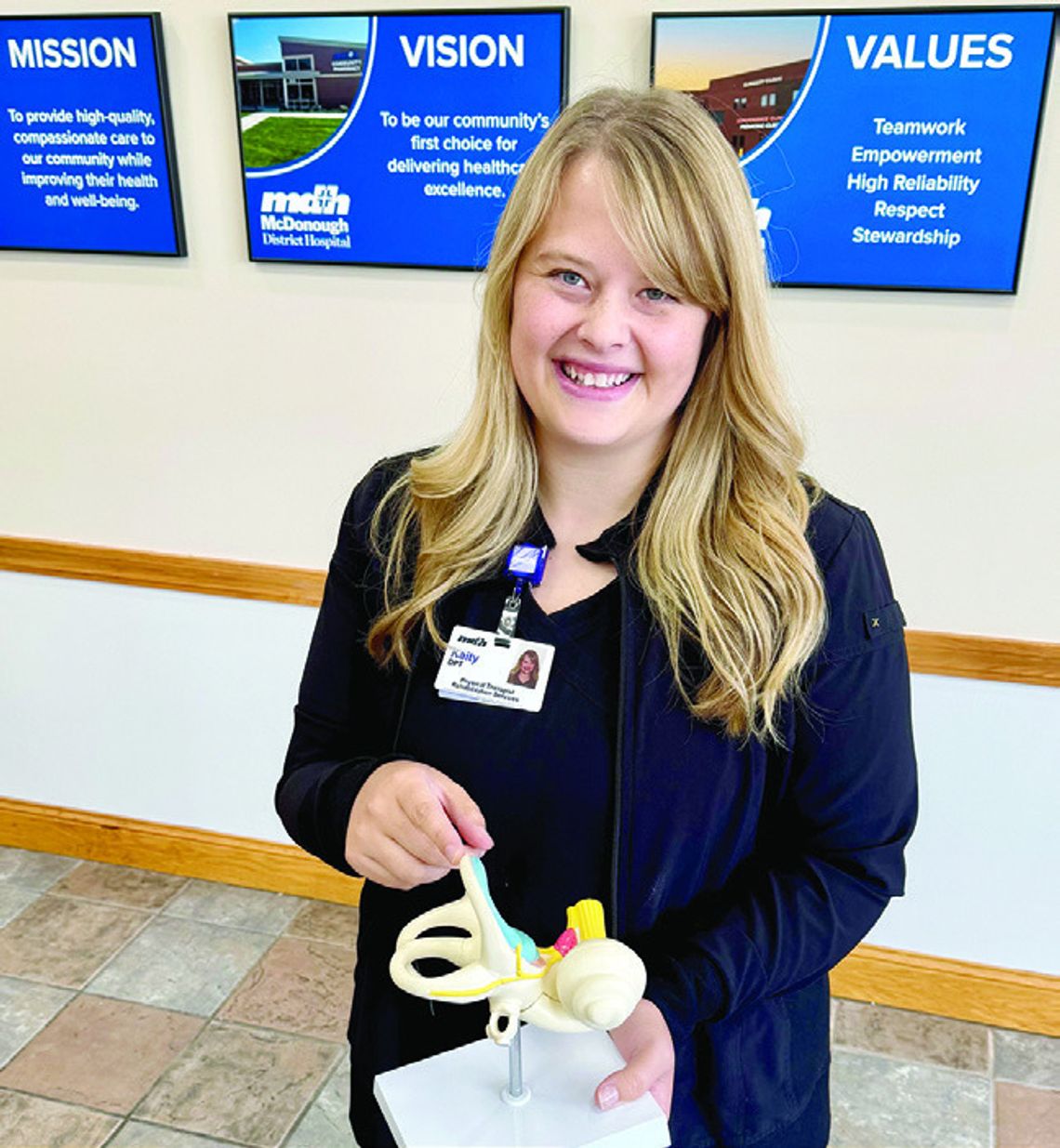Physical Therapy Can Help People With Dizziness, Vertigo Smaller than a dime, the body’s vestibular system is critical for balance, coordination and spatial orientation.
Its apparatus is wedged behind the eardrum between the three miniscule bones and snail-shaped cochlea that are responsible for hearing. When it is working well, the system is unnoticed.
When it’s not, dizziness and vertigo are the easily recognizable symptoms.
They, in turn, can cause loss of balance, nausea, vomiting, blurred vision and other problems.
Physical therapists in McDonough District Hospital’s Vestibular Rehabilitation Program are specialists in treating peripheral vertigo, dizziness or vertigo that is not caused by brain or spinal cord disorders. This includes several diagnoses, but the most common are benign paroxysmal positional vertigo, vestibular neuritis, labyrinthitis and Meniere’s disease.
“Many times, I see people who think dizziness or vertigo is something they have to live with,” said Kaity Kipling, DPT, one of three physical therapists at MDH who specialize in vestibular rehabilitation. “There's research that shows up to 40% of the population who are 40 years and older will experience vertigo or dizziness at some point in their life. This shows there is a large population that could benefit from vestibular therapy.”
Dizziness and vertigo are not the same thing.
“Dizziness is an umbrella term for a lot of symptoms, like lightheadedness or feeling off balance or woozy, or like you’re floating. Vertigo is that room-spinning sensation,” Kipling said.
Physical therapists begin treatment by examining patients to determine the cause of dizziness or vertigo and then developing individualized treatment plans for each patient. Depending on the diagnosis, some patients improve in one or two appointments while other diagnoses may require several visits to the MDH’s outpatient treatment center in the hospital or its clinic on North Lafayette Street in Macomb.
“These intense symptoms can be all-consuming and scary,” Kipling said. “On the first day, we make sure that we educate patients about what we're finding, the anatomy of the vestibular system and why they feel like they do. When patients understand why these symptoms are happening, it can help decrease anxiety and fear which, in turn, can help decrease their systems as well.”
Benign paroxysmal positional vertigo
Benign paroxysmal positional vertigo (BPPV) is the most common cause of vertigo. It is caused by the dislocation of tiny crystals in the inner ear. The crystals move into one or more of the three fluid-filled canals of the vestibular system. When this happens, certain head movements cause immediate symptoms including spinning, dizziness, blurred vision and nausea. The symptoms don’t last long with each head movement but they are severe.
“I’ve had it four times.
It's not fun,” said Lawrence Michaelson, DPT. “The crystals are microscopic; that's how small they are. But they can cause big problems.
About 50 percent of my vestibular rehabilitation patients have BPPV.”
BPPV can be caused by the aging process, a blow to the head, dehydration or unusual anatomy of the inner ear, or it can be idiopathic, a word that means the cause is unknown.
It occurs primary in people who are middle age or older.
Because of their size, ear crystals cannot be seen through diagnostic imaging procedures. Instead of using high-tech magnetic resonance imaging (MRI), physical therapists employ hands-on maneuvers to diagnose and treat the problem.
“We put people's heads in certain positions to try to reproduce their symptoms,” Michaelson said. “If crystals are in one of the canals, they may cause eye movements called nystagmus. We watch the eyes and look for other sudden symptoms such as dizziness and nausea.
Through specific positions we can determine which canals the crystals are in.”
Physical therapists use a repositioning maneuver to put the crystals back into place. Michaelson said the manipulation ends the spinning feeling with head movement but patients may feel dizziness for a while after treatment.
Because dehydration may lead to BPPV, Michaelson encourages drinking enough water to maintain hydration, which is beneficial for good health overall.
“Dehydration can lead to dizziness and vertigo. The best and least expensive thing for anyone to do is to drink more water,” he said.
“Otherwise, there's not really anything else you can do to prevent it.”
Patients who have been treated for BPPV at MDH may return for a free screening examination to determine if there is a recurrence.
Treatment, however, must be ordered by a physician or health care provider.
Vestibular neuritis, labyrinthitis and Meniere’s disease
Vestibular neuritis and labyrinthitis are caused by inflammation of nerves.
They can be treated with medication prescribed by a physician or other health care provider and physical therapy to improve dizziness and vertigo caused by the inflammation and inner ear dysfunction.
Unlike BPPV, vertigo or dizziness caused by these ailments is constant and can last for hours or days at a time.
Vestibular neuritis doesn’t affect hearing, but the rarer labyrinthitis can temporarily reduce hearing.
Meniere’s disease causes permanent, but not complete, hearing loss and balance problems. After it is diagnosed, physical therapists work with patients to improve balance and modify activities to help manage symptoms.
Inner ear-eye connection
“The vestibular system also is connected to the eyes through the vestibular ocular reflex or VOR,” Michaelson said. “That allows you to be walking, riding a bike or riding in a car and be able to look at things and keep them clear as your head is moving. When you have a dysfunction with the VOR, your eyes are not moving at the same rate as your head. In treatment, we're trying to get the eyes to be able to catch up to the speed of the head movement.”
The treatment technique is called habituation.
“Basically, we’re working to get the reflex to work the way that it should normally,” Michaelson said. “We have patients focus on a target and then we have them turn their heads side to side and up and down, trying to work faster and faster to be able react at the speed at which they are going.”
Besides habituation therapy, physical therapists teach patients exercises and provide education about modifying activities to manage their symptoms.
Dedication to improving quality of life “When patients come into therapy, we can show them that dizziness and vertigo are treatable. Most people are surprised that physical therapy can treat dizziness, which makes it a very rewarding area to work in when you can make such a drastic change in someone’s quality of life,” Kipling said.
Kipling, who works at the clinic on North Lafayette Street, learned about physical therapy after she injured her knee while playing volleyball at Bushnell-Prairie City High School. She had already been thinking about pursuing a career in health care.
“Physical therapists helped to get me back to playing my sports,” she said. “I knew I was going to come back and help the community that helped raise me.”
Michaelson majored in fitness and wellness before earning his physical therapy degree. He came to MDH from Utah to fulfill a contract position in the hospital’s Sports Medicine and Rehabilitation Department. When a permanent full-time physical therapy position opened, he knew he wanted to stay in Macomb.
“I could already tell from being with my coworkers that it was a good job and a good place to work,” he said.
“This is where I should be.
Macomb is a great place.”
Angelica Hoenig, DPT, also provides vestibular rehabilitation at the North Lafayette Street location.











